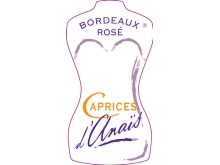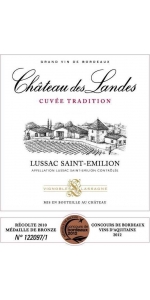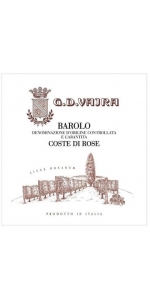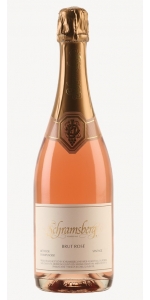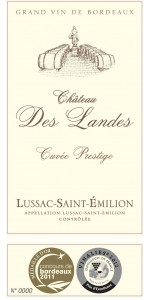Landes Caprices d'Anais Rose 2018
| Country: | France |
| Region: | Bordeaux |
| Winery: | Chateau des Landes |
| Grape Types: | Cabernet Sauvignon Merlot |
| Organic: | Yes |
| Vintage: | 2018 |
| Bottle Size: | 750 ml |
Landes Cuvee Tradition Lussac Saint Emilion is made from 80% Merlot, 15% Cabernet Sauvignon and 5% Cabernet Franc
Color: deep ruby intense color.
Aroma: racy and aromatic nose with aromas of ripe red fruit.
Taste: this wine is silky, round and smooth first taste, with aromas of raspberries, and blackcurrant, powerful and complex finish.
G.D. Vajra Barolo Coste di Rose is made from 100 percent Nebbiolo.
The Coste di Rose is a very seductive wine right out of the gate. Cherries and roses burst on the nose, with hints of amarena, red hard candy, wild berries, wet stone, mint and thyme. The palate is radiant and expressive, with all of the signature elements of Coste di Rose in nice evi-dence: the ethereal character, the saline, up-front tannic structure, and further whiffles of roses and cherries in the finish.
Review:
This wine shows a darker and more savory profile than Vajra’s Costa di Rose, its black-cherry flavors tinged with notes of licorice and tobacco. Scents of lavender and violet lend a delicate touch to the wine, which continued to gain verve and freshness with time in the glass.
-Wine & Spirits 96 Points
Schramsberg Brut Rosé is fruitful, complex and dry, making it both versatile with food and delicious by itself as an apéritif. The character of the wine is most strongly influenced by bright, flavorful Pinot Noir grown along the coast from southern Mendocino County to northern Marin County.
Reviews:
"These bubbles are fresh and zesty, with aromas of strawberry, raspberry, apricot, orange creamsicle and blood orange zest on the nose. Creamy, super-firm and tiny bubbles mark the midpalate, while flavors of pink grapefruit and guava overtake the mouthfeel. The massive acidity, salinity and mouthwatering finish make one want to eat and drink more."
-Wine Enthusiast 94 Points
Landes Cuvee Prestige Lussac Saint Emilion is made from 80% Merlot, 15% Cabernet Sauvignon and 5% Cabernet Franc
Color: deep dark ruby intense color
Aroma: racy and aromatic nose with aromas of ripe red fruit, floral notes, wood and spice with a touch of vanilla.
Taste: this wine has a good structure and some powerful aromas of raspberries, blackcurrant, vanilla and it is powerful with a complex finish. The oak is present but not dominant. The tannins are quite well integrated already.
Average age of the Vines: 60 years Yield : 50 hectoliters / hectare. Grape picking: harvest by machine. Vats: Stainless steel thermoregulated and computerized. Fermentation: 45 to 50 days with a final 35°C warm steeping. Winemaking: Malolactic fermentation in new oak barrel. Ageing: 16 months in new French Oak barrels from Allier and Limousin. Annual production: 10,000 bottles. (833 cases)
Review:
"This shows aromas of ripe blackcurrants and blackberries with walnuts, spices and cocoa. Medium-bodied with firm tannins and a bright, succulent character. Racy finish. Drink or hold."
- James Suckling (December 2022), 92 pts
Landes Cuvee Tradition Lussac Saint Emilion is made from 80% Merlot, 15% Cabernet Sauvignon and 5% Cabernet Franc
Color: deep ruby intense color.
Aroma: racy and aromatic nose with aromas of ripe red fruit.
Taste: this wine is silky, round and smooth first taste, with aromas of raspberries, and blackcurrant, powerful and complex finish.
Landes Cuvee Tradition Lussac Saint Emilion is made from 80% Merlot, 15% Cabernet Sauvignon and 5% Cabernet Franc
Color: deep ruby intense color.
Aroma: racy and aromatic nose with aromas of ripe red fruit.
Taste: this wine is silky, round and smooth first taste, with aromas of raspberries, and blackcurrant, powerful and complex finish.
Landes Caprices d'Anais Rose is made from 50% Merlot + 50% Cabernet Sauvignon
This cuvée was created in 2005 to honor Nicolas's first daughter Anais. Caprice d'Anais means "Anais' Whim".
Color: Pale pink with salmon hues.
Aromas: quite aromatic nose dominated with floral (linden and elderberry) and fruity (cherry, strawberry and raspberry) notes.
Flavors: Quite similar to the aromas, with red fruit and floral flavors. The wine is easy to drink with a good fresh and zesty finish.
Great on its own during summer time, it will also pair very well with grilled salmon, salads, roasted chicken or any white meat dish.
Chateau des Lande Estate
Château des Landes was created in 1952 by Paul Lassagne, Nicolas' grandfather. He started with only 2 hectares and grew to 7 hectares in 1979.
His son, Daniel, came along and bought more vineyards surrounding the cellar and he managed to grow to 27 hectares in almost 20 years.
In 2001, Nicolas, came aboard and decided to continue on the family tradition bringing his expertise and his knowledge.
Nicolas is now in charge of the Estate and he manage 27.2 hecatres of vineyards (68 hectares).
Chateau de Landes Vineyard
27.2 hectares (68 acres) of vineyard with a density of 5,500 vineplants per hecatres ( 2,217 vineplants per acre).
The average age of the vine is 30 years.
The soil is mostly a mix of Clay and limestone, while the subsoil is white clay.
- back
Ruby red with soft purplish reflections. Rich and complex on the nose, very reminiscent of small fruits of brambles, black cherry and a very delicate hint of softwood. On the palate it is decisive, complex and extraordinarily persistent.
Review:
Complex aromas of ripe fruit, toffee, cedar and smoke. Medium body, round and creamy tannins and a fresh, juicy finish.
-James Suckling 94 Points
Proelio Puerto Rubio Rioja Tempranillo 2019 is 100% Tempranillo.
Sourced from a vineyard at 505 metres above sea level in San Vicente de la Sonsierra, the wine takes its name from the site it is located on. The soils are primarily composed of depleted limestone in the subsoil and pebbles on the topsoil. These types of soils offer long-ageing capacity, freshness, volume and structured wines.
Fresh, structured and complex, this wine is very aromatic, with intense aromas of wild black fruits, accompanied by deep balsamic aromas and licorice. A silky texture and mineral notes, it is round, powerful and polished on the palate with flavors of black fruits, prunes, balsamic and spice. A long and persistent finish.
Meat and game, either grilled, baked or stewed, pastes, creams and soups, all kind of meat recipes, roast lamb.
Review:
This is a spicy Rioja with aromas of mulberries, spiced cherries, cinnamon stick, licorice and dill. Turns to walnuts and roasted chestnuts. Chewy and full-bodied, with firm yet polished tannins. Well structured, deep and persistent. Drink from 2024.
-James Suckling 94 Points

